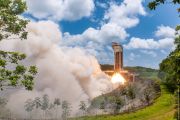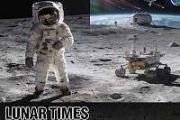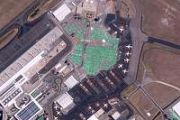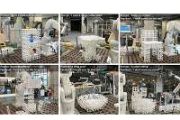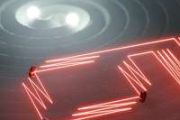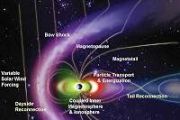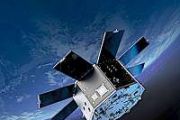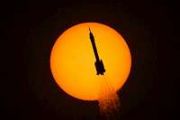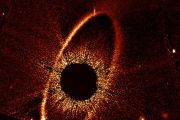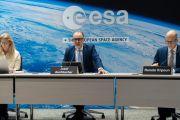
Copernical Team
Laser ultrasound used to reveal the elasticity of space rock for the first time
 Scientists and engineers at the University of Nottingham have measured the stiffness of space rock for the first time.
Many meteorites are made of crystalline materials, formed under exotic conditions that cannot be replicated on earth. The stiffness of the crystals that make up these materials has historically been difficult to measure and normally this requires scientists to grow a speci
Scientists and engineers at the University of Nottingham have measured the stiffness of space rock for the first time.
Many meteorites are made of crystalline materials, formed under exotic conditions that cannot be replicated on earth. The stiffness of the crystals that make up these materials has historically been difficult to measure and normally this requires scientists to grow a speci Streak Patterns on Mars Likely Formed by Dust Rather Than Water Flow
 New findings from Brown University and the University of Bern challenge the long-standing theory that certain streaks on Martian slopes are formed by flowing water. Using machine learning to analyze a comprehensive dataset of slope streak features, the research suggests these formations are more likely the result of dry processes, including wind and dust activity.
For decades, scientists h
New findings from Brown University and the University of Bern challenge the long-standing theory that certain streaks on Martian slopes are formed by flowing water. Using machine learning to analyze a comprehensive dataset of slope streak features, the research suggests these formations are more likely the result of dry processes, including wind and dust activity.
For decades, scientists h China's Queqiao-2 Satellite Ready for Global Lunar Mission Support
 Queqiao-2, China's dedicated relay satellite for lunar landing missions, is now poised to support both domestic and international lunar exploration efforts, according to the Deep Space Exploration Laboratory.
First launched in March 2024, Queqiao-2, also known as Magpie Bridge 2, played a critical role in the Chang'e 6 mission, which successfully retrieved samples from the far side of the
Queqiao-2, China's dedicated relay satellite for lunar landing missions, is now poised to support both domestic and international lunar exploration efforts, according to the Deep Space Exploration Laboratory.
First launched in March 2024, Queqiao-2, also known as Magpie Bridge 2, played a critical role in the Chang'e 6 mission, which successfully retrieved samples from the far side of the NASA's Perseverance Mars Rover to Take Bite Out of 'Krokodillen'`
 Scientists expect the new area of interest on the lower slope of Jezero Crater's rim to offer up some of the oldest rocks on the Red Planet.
NASA's Perseverance Mars rover is exploring a new region of interest the team is calling "Krokodillen" that may contain some of the oldest rocks on Mars. The area has been on the Perseverance science team's wish list because it marks an important boun
Scientists expect the new area of interest on the lower slope of Jezero Crater's rim to offer up some of the oldest rocks on the Red Planet.
NASA's Perseverance Mars rover is exploring a new region of interest the team is calling "Krokodillen" that may contain some of the oldest rocks on Mars. The area has been on the Perseverance science team's wish list because it marks an important boun Sols 4541-4542: Boxwork Structure, or Just "Box-Like" Structure?
 On Earth planning date: Wednesday, May 14, 2025 - we came into another strange and interesting workspace that is as exciting as the one we had on Monday. This is our first arrival at a potential boxwork structure - a series of web-like, resistant ridges visible in orbital images that we have been looking forward to visiting since we first saw them. Today's observations will be the first step to
On Earth planning date: Wednesday, May 14, 2025 - we came into another strange and interesting workspace that is as exciting as the one we had on Monday. This is our first arrival at a potential boxwork structure - a series of web-like, resistant ridges visible in orbital images that we have been looking forward to visiting since we first saw them. Today's observations will be the first step to UT Austin Researchers Uncover Key Link in Early Martian Water Cycle
 Graduate students from The University of Texas at Austin have made a significant breakthrough in understanding Mars' ancient water cycle, filling a crucial gap in the link between surface water and groundwater.
Mohammad Afzal Shadab and Eric Hiatt developed a computer model that calculates the time it took for water to move from the Martian surface to deep underground aquifers, a process t
Graduate students from The University of Texas at Austin have made a significant breakthrough in understanding Mars' ancient water cycle, filling a crucial gap in the link between surface water and groundwater.
Mohammad Afzal Shadab and Eric Hiatt developed a computer model that calculates the time it took for water to move from the Martian surface to deep underground aquifers, a process t Chinese Company Conducts Fifth Sea-Based Rocket Launch
 Galactic Energy, a Beijing-based private rocket manufacturer, successfully completed its fifth sea-based launch of the Ceres 1 carrier rocket on Monday. The rocket lifted off at 3:38 pm from a modified deck barge in the Yellow Sea off the coast of Shandong Province, delivering four satellites into a low-Earth orbit approximately 850 kilometers above the planet.
The satellites, developed by
Galactic Energy, a Beijing-based private rocket manufacturer, successfully completed its fifth sea-based launch of the Ceres 1 carrier rocket on Monday. The rocket lifted off at 3:38 pm from a modified deck barge in the Yellow Sea off the coast of Shandong Province, delivering four satellites into a low-Earth orbit approximately 850 kilometers above the planet.
The satellites, developed by Space tourism's growth blurs the line between scientific and symbolic achievement
 On April 14, 2025, Blue Origin launched six women - Aisha Bowe, Amanda Nguyn, Gayle King, Katy Perry, Kerianne Flynn and Lauren Sanchez - on a suborbital journey to the edge of space.
The headlines called it a historic moment for women in space. But as a tourism educator, I paused - not because I questioned their experience, but because I questioned the language. Were they astronauts or sp
On April 14, 2025, Blue Origin launched six women - Aisha Bowe, Amanda Nguyn, Gayle King, Katy Perry, Kerianne Flynn and Lauren Sanchez - on a suborbital journey to the edge of space.
The headlines called it a historic moment for women in space. But as a tourism educator, I paused - not because I questioned their experience, but because I questioned the language. Were they astronauts or sp Second CubeSat joins ESA’s Ramses mission to asteroid Apophis

Space tourism's growth blurs the line between scientific and symbolic achievement. A tourism scholar explains
This request seems a bit unusual, so we need to confirm that you're human. Please press and hold the button until it turns completely green. Thank you for your cooperation!
Press and hold the button
If you believe this is an error, please contact our support team.
185.132.36.159 : e63ba7d4-d98b-4f15-87cd-e9e8f0bb












